My arrival in Europe caught me quite off guard. With all the travel
I've done over the past few years, I thought I knew exactly what to expect
from traveling in Europe; Western culture was Western culture. It would
be like th US, except there would be a bunch of castles, all the people
would be smoking and stylishly dressed, the food would actually be good,
and the McDonalds would serve the "Royale with Cheese" instead of the
Quarter Pounder. I had always forgone the tameness and sameness of travel
in Europe for the exotic and unpredictable Third World. But I figured that
I should at least give Europe a look.
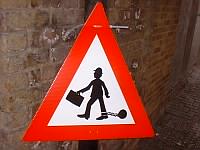 |
Beware of working stiffs
London, England (17Oct00) |
Being of British descent, I have always felt a special connection to England.
I even had the papers to prove it; Much of the last six months of my four
month stopover in San Francisco was dedicated to acquiring a British
passport, which dramatically arrived only hours before my departure. I had
to make sure I was home the entire last day, lest they deliver it in my
absence. They did, however, attempt to deliver it in the five minutes I
was in the shower, and it took serious groveling on the phone to FedEx to
have them come back.
It was this very pedigree which made me feel so out of place the moment
I arrived in London. A 6'4" man with pasty white skin and blond hair is
the center of attention in a tiny village in the Andes, but in London, I
just disappeared into the buzzing mass of pale white. I was an outsider,
yet I was indistinguishable in the middle of it. I was invisible.
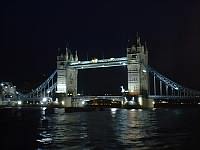 |
Tower Bridge
London, England (17Oct00) |
My new found invisibility allowed me to move freely without making even
the slightest ripple. Under trademark wet, grey skies, I took in the token
sights of Tower Bridge, Westminster Abbey, and the British Tate Museum. At
the rate I was shedding pounds in my whirlwind tour, it was fortunate that
my British stopover was only a day. Before I knew it, I was on a plane to
Madrid, Spain.
Once in Spain, I felt a sudden sense of relief. Being back in a Spanish
speaking country brought back a feeling of adventurousness, yet I still
maintained a degree of invisibility. With nowhere in particular I had to
be, I just stopped and relaxed. It was probably the first time ever in my
travels when I didn't have something to focus on. I wasn't constantly
being stared at by the locals, I wasn't thinking of how many kilometers I
had to ride that day, I didn't have a distant deadline to structure my
time around. It was strange; I could spend a month just sitting in cafes
thinking and drinking coffee if I wanted to.
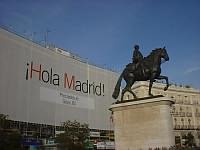 |
Hello Madrid!
Madrid, Spain (19Oct00) |
I decided that a couple days sounded like a more reasonable time to sit
and think. Too much time with a caffeine fueled hyperactive mind is a
dangerous thing. My time alone didn't last long. I decided to treat
myself to a nice dinner at a restaurant recommended by a friend. As I was
sipping my complimentary glass of champagne, a woman at the next table, not
realizing that the champagne was included with the meal, asked "What are
you celebrating?" I told her that I wasn't really celebrating anything,
but soon we were talking. "No one eats alone in Spain. It is very sad,"
she said. To guarantee that the tragedy would not be repeated, she
invited me to join her and a group of friends for dinner the next
night.
So, barely three days into my European jaunt, I found myself thrust into
the heart of Spanish social life. Spanish life seems to be anchored on
four pillars: eating, drinking, smoking, and talking. My lack of smoking
still left me well anchored, and I made up for the omission by
overcompensating with the others.
Spanish nightlife begins with dinner, usually about 10pm, with the more
people the better. There were seven of us, and we quite quickly did
serious damage to various plates of olives, sliced meat, fish, and far too
many bottles of wine. With the evening off to a good start, we then drank
and talked our way from one hot spot of Madrid nightlife to the next,
ultimately ending up in a club called "El Guillotine." By the end of the
evening, at around 5am, we had solved all the world's problems, contemplated
the meaning of life, and discussed culture from around the world.
Alas, by the morning, all the great insight had faded, only to be
replaced by a mind-numbing hangover. Welcome to Spain.
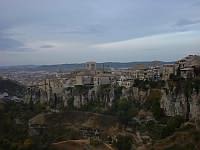 |
The "Casas Colgadas"
Cuenca, Spain (22Oct00) |
I decided that I had been in Madrid long enough,and it was time to get
moving. I planned a frantic sidetrip to a small village outside Madrid,
called Cuenca. Cuenca is known for its famous "casas colgadas," houses
built on the teetering edge of a mountain, their terraces spilling down into
the canyon. Even under black skies, it was a beautiful sight; too
beautiful perhaps, as I managed to sprain my ankle, looking back at the view
instead of on the path in front of me.
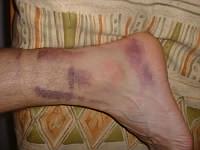 |
Oops...
Cuenca, Spain (22Oct00) |
My frantic pace once again slowed, I hobbled back to the bus station and
headed back to Madrid. When I was in Madrid previously, I had met a group
of elder hostal travelers, and they invited met to join them for a bullfight
later in the week. Having never seen one, and having just missed seeing
one in Mexico City, I accepted. So once back from Cuenca, I went straight
to the bull ring. I was told which section thwey would be sitting in, but
it wasnīt clear when it came time to buy a ticket, so I bought one right up
front, assuming that I could go and visit them in the cheaper seats without
a problem. I went straight to their section, and watched the first half of
one fight talking with them. The group was from many places; Canada,
America, Europe, and their great spirits gave me hope that you can still
travel the world in the autumn of life.
Since I had paid quite a lot (4000 pts = US$20) from prime seats, I
decided to make my way down to my seat. But apparently, you can't reenter
the arena during a fight, so I had to wait and watch on TV until the first
bull was dead. There would be five more.
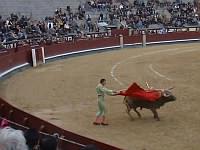 |
OlŤ
Madrid, Spain (22Oct00) |
Once the bull had been killed, I made my way up front. There, not 15
feet from my seat, lay the tortured, bloody body of the dead bull from the
previous fight. Blood stained the once crisp white of the bull's nose and
mouth. The bull was roped up, tied to a horse, and dragged out of
the ring in preparation for the next fight
Each fight had the exact same protocol. First, the bull, healthy and
fresh, would be released into the ring. Junior bullfighters would step out
from behind barracades waving bright pink capes, inducing the bull to
charge. Just as he approached one bullfighter, another would appear off in
the distance, and the bull would change course and charge again. After a
few times around the ring, horns would blow, and men on horseback would
enter. They carried with them spiked poles, and it was their job to stab
the bull in the back, weakening and angering him. In order to prevent the
horse from doing the obvious thing and running from the charging bull, it
was blindfolded. Fortunately, modern times have benefitted the horses, and
they are now covered with padding to dull the bull's fierce blow. With
blood gushing from the bull's back, the horses would head out with the next
blast of horns, and two men would enter. Each would have two barbed sticks in
their hands, and in turn, each would attempt to jam the barbs into the back of
the bull as he charged. They would then repeat this, resulting in up to eight
poles stuck in the bull's back. By this point, the bull would be angry yet
weakened, and would run around the ring looking like a bleeding bagpipe,
sticks bouncing to and fro.
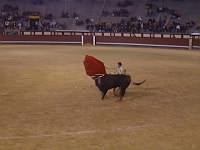 |
Bullfight
Madrid, Spain (22Oct00) |
With the final horn blast, the matatador would enter. Dressed in elaborate
guilded attire and wielding a red cape and sword, the matador got to work.
He would go into the center of the ring and tease the bull, trying to get him
to charge as closely as possible without inflicting any injuries. There
was obviously a fine art to it, and I'm sure a refined spectator would know
a good move from a bad one, but it seemed that the smoother and more daring
the move, the better the applause. After playing with the bull for about
ten minutes, the matador would switch swords, and then focus on the kill. A
clean kill would drop the bull to the ground in a second, but that seemed to be
the exception. On several occasions, the matador would stab
clumbsily, like a nurse hunting for a buried vein. After each tab, the
partially buried sword would have to be extracted. When the matador got
into trouble, the junior bullfighters would quickly appear on the scene and
distract the bull while the matador regained composure.
After six bull fights, the tally was grim: matadors 6, bulls 0. I
headed back to my hotel. After spending my first week under the continual
threat of rain, I decided that moving south was my best bet for sun, so I
set a course for the state of Andalucia.
Andacucia is a remarkable place. The southernmost part of Spain, it is
warm, friendly, and rich with history and culture. Once under Moorish
control, it has some of the most impressive mosques anywhere.
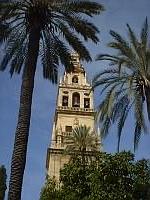 |
The Mezquita
CÚrdoba, Spain (24Oct00) |
CÚrdoba is the site of one of these mosques, the Mezquita, which is
centered in the Juderža, the ancient Jewish quarter. CÚrdoba is a popular
tourist stop, and the narrow streets would often be clogged with packs of
tour groups. CÚrdoba is also home to one of the finest youth hostels in
Spain. While it is questionable whether I qualified as a youth anymore,
youth hostals are a great place to meet other travelers, and that's exactly
what happened.
From the moment I arrived in CÚrdoba to the moment I left, I was always
spending time with some other traveler. I met Soren from Denmark, Cheryl
from Canada, and Nikolas from France. My roommates were Russian-American
and Guatemalan.
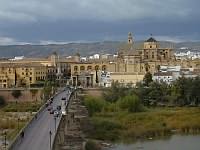 |
The Mezquita again
CÚrdoba, Spain (24Oct00) |
Hostels usually have a broad range of people staying in them, from 18 yr
olds on their first trip away from home, to people who have been on the
road for ten years with no end in sight. All share a love of travel, and
it's always easy to find someone who wants to spend a night on the town.
We spent our evenings drinking, eating, and dancing. I soon realized that
I was no longer invisible; I was fully plugged into the traveler network.
The pace only increased once I hit Sevilla. Sevilla is not only home to
Flamenco and bullfighting, but it also had the most active nightlife I've
ever seen. Every night, from about 10 until about 4am, the plazas would
be entirely overrun with thousands of young people, all seemingly aged
16-23. They would all drink whisky and coke, all carried in
identical plastic bags and served in identical plastic cups. On my second
night there, I and a man named Chris from South Africa decided to check out
this mysterious phenomena.
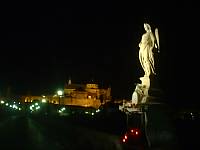 |
CÚrdoba at night
CÚrdoba, Spain (24Oct00) |
We walked through numerous tranquil streets and empty plazas until we
hit THE plaza, which must have had a thousand people in it. As we walked
through the crowd, one group stopped us and offered us drinks - the
proverbial whisky and coke. A while later, a homeless man came by, and
soon he too was partaking in the festivities. When we ran out of drinks,
Chris and I went to buy more. It turns out that all the local bars sell
"party kits"; a bag with a bottle of whisky, a bottle of coke, a big bag
of ice, and cups, all ready to go. The whole lot cost 2000 pts (about
US$10.) In America, if all the youth in town went out on the streets
drinking until 6am, it would be a disaster, but in Spain, it somehow works.
Even the old folks were out in the bars 'till the wee hours, drinking,
talking, and eating tapas.
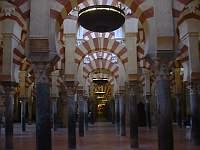 |
Inside the Mezquita
CÚrdoba, Spain (25Oct00) |
Staying out until 6 made sleeping in a necessity, but the woman who ran
the hotel didn't see it that way. At 7 in the morning, I heard tapping on
the window, and it took several minutes of confused replies until I finally
realized that she was knocking on the next room over. It was hard to tell;
the rooms were so tiny that my head and my feet both touched the walls at
the same time. She was balling out the person next door, who had
apparently brought someone back with him, but he had only paid for a
single. The woman didn't win many hospitality points with me either,
tellilng me to make sure I took a short shower once I she found out that I was
checking out. The rooms more than made up for the lack of hostility,
however, opening onto a beautifully warm, sun drenched terrace.
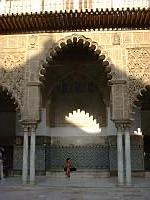 |
The Alcazŗr
Sevilla, Spain (25Oct00) |
After a more mellow evening with yet another traveler, Caleb, a fellow
photographer from Portland, I decided to follow up on an offer I had
received from Cheryl, back in CÚrdoba, to drop by and stay with her and her
friend Adrian.
Adrian, a researcher from England, was living in Sevilla for a few
months to do research on trade between England and the New World.
Unbeknownst to him, Cheryl invited me to stay, and he was a most gracious
host. when I arrived, he, Cheryl, and another stray traveler Cheryl had
invited named Kylie were getting ready to do a day trip to a town called
Ronda. I joined in.
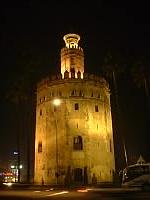 |
The Tower of Gold
Sevilla, Spain (26Oct00) |
Adrian not only chauffered us in a rental car, but he also served as
tour guide. There is no better guide to have than someone who has
dedicated his professional life to the study of history. He knew all the
details of past rulers, old trade routes, and numerous colonial
atrocities. It was great to have all the history as we enjoyed the
sights.
To get to Ronda, we had to drive over the Sierras, a small but
picturesque mountain range. Along the way, the small, whitewashed villages
of Zahara, Grazalema, and Ubrique dotted the hillsides. With a late start
and frequent stops, we didn't actually reach Ronda until well after dark,
but what a sight it was. Running through the center of town was a deep
gorge, so deep that even when floodlit at night, it was barely possible to
make out the bottom. One of the three bridges, the one built during
Christian times, was an impressive piece of work, with monsterous stone
columns that disappeared into the dark depths of the gorge.
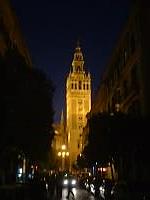 |
The Giralda
Sevilla, Spain (28Oct00) |
The next day our sightseeing tour went to Cŗdiz, a southern port, by
train. We actually ended up stuck most of the day in Puerto de Santa
Maria, waiting for a boat to Cŗdiz, but it didnīt really matter.
Wherever we went, we spent most of our time in bars eating, drinking, and
talking, and seeing as Puerto de Santa Maria was the center of sherry
production, it gave us an opportunity to sample the local wares.
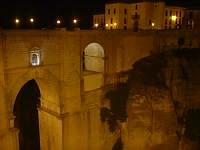 |
The bridge in Ronda
Ronda, Spain (29Oct00) |
I ended up spending another day back in Sevilla, doing laundry and
hanging out with my new friends. My lack of a schedule and nice weather
gave me no incentive to get moving. Adrian's apartment overlooked an old
convent, and the lines for drying clothes were on the roof. At some point
during the day, one of my shirts blew off the roof and drifted down into a
tree in the courtyard of the convent. I had to go knock on the door and
ask one of the sweet old nuns to go and retrieve it from a tree for me.
I really enjoyed the time I spent with
Cheryl, Adrian, and Kylie; it was
great to have some deep, long conversations to offset the wild social scene
of Spain. Soon, however, it was time to move again. I had my sights set
on a new destination; Portugal.



